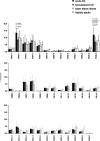Polyclonal expansion of TCRBV2- and TCRBV6-bearing T cells in patients with Kawasaki disease
- PMID: 10233729
- PMCID: PMC2326769
- DOI: 10.1046/j.1365-2567.1999.00695.x
Polyclonal expansion of TCRBV2- and TCRBV6-bearing T cells in patients with Kawasaki disease
Abstract
We examined T-cell receptor (TCR) usage, cytokine production and antibody responses to superantigens in patients with Kawasaki disease (KD) to facilitate a better understanding of the immunopathogenesis of KD. The mean percentage of VB2- or VB6. 5-bearing T cells in peripheral blood mononuclear cells (PBMC) of patients with acute-phase KD was significantly higher than that of patients in the convalescent phase of KD or in healthy donors. Expansion of VB2- or VB6.5-bearing T cells was polyclonal because DNA sequences in the complementarity determining region 3 of VB2- and VB6.5-positive cDNA clones were all different from each other. The plasma levels of interleukin (IL)-1beta, IL-2, IL-6, IL-8, IL-10, interferon-gamma (IFN-gamma), tumour necrosis factor-alpha (TNF-alpha) and granulocyte colony-stimulating factor (G-CSF) were elevated in the acute phase of KD. We previously reported that streptococcal pyrogenic exotoxin C (SPEC) was a potent stimulator of VB2- and VB6.5-positive T cells and, furthermore, serum levels of anti-SPEC antibodies were significantly higher in patients with acute and convalescent KD than in age-matched controls. The results of the present study, together with those of our previous report, suggest that SPEC induces activation and polyclonal expansion of VB2- and VB6.5-positive T cells, and that SPEC-induced activation of T cells may lead to the pathogenesis of KD.
Figures
Similar articles
-
Relation of streptococcal pyrogenic exotoxin C as a causative superantigen for Kawasaki disease.Pediatr Res. 2003 Mar;53(3):403-10. doi: 10.1203/01.PDR.0000049668.54870.50. Pediatr Res. 2003. PMID: 12595587
-
Inhibition of IL-12 synthesis of peripheral blood mononuclear cells (PBMC) stimulated with a bacterial superantigen by pooled human immunoglobulin: implications for its effect on Kawasaki disease (KD).Clin Exp Immunol. 1998 Nov;114(2):311-9. doi: 10.1046/j.1365-2249.1998.00712.x. Clin Exp Immunol. 1998. PMID: 9822292 Free PMC article.
-
Characterization of CD4+ T helper cells in patients with Kawasaki disease (KD): preferential production of tumour necrosis factor-alpha (TNF-alpha) by V beta 2- or V beta 8- CD4+ T helper cells.Clin Exp Immunol. 1995 Feb;99(2):276-82. doi: 10.1111/j.1365-2249.1995.tb05545.x. Clin Exp Immunol. 1995. PMID: 7851022 Free PMC article.
-
The pathogenesis of Kawasaki disease and superantigens.Jpn J Infect Dis. 1999 Aug;52(4):141-5. Jpn J Infect Dis. 1999. PMID: 10592892 Review.
-
Immunological abnormalities in Kawasaki disease with coronary artery lesions.Acta Paediatr Jpn. 1991 Dec;33(6):745-51. doi: 10.1111/j.1442-200x.1991.tb02603.x. Acta Paediatr Jpn. 1991. PMID: 1801554 Review.
Cited by
-
Cytokines and adhesion molecules in the pathogenesis of vasculitis.Curr Rheumatol Rep. 2000 Oct;2(5):402-10. doi: 10.1007/s11926-000-0040-8. Curr Rheumatol Rep. 2000. PMID: 11123090 Review.
-
Aetiological Significance of Infectious Stimuli in Kawasaki Disease.Front Pediatr. 2019 Jun 28;7:244. doi: 10.3389/fped.2019.00244. eCollection 2019. Front Pediatr. 2019. PMID: 31316950 Free PMC article. Review.
-
Superantigen involvement and susceptibility factors in Kawasaki disease: profiles of TCR Vβ2+ T cells and HLA-DRB1, TNF-α and ITPKC genes among Filipino patients.Int J Mol Epidemiol Genet. 2013;4(1):70-6. Epub 2013 Mar 18. Int J Mol Epidemiol Genet. 2013. PMID: 23565324 Free PMC article.
-
Our Evolving Understanding of Kawasaki Disease Pathogenesis: Role of the Gut Microbiota.Front Immunol. 2020 Jul 24;11:1616. doi: 10.3389/fimmu.2020.01616. eCollection 2020. Front Immunol. 2020. PMID: 32793240 Free PMC article. Review.
-
Antibodies and Immunity During Kawasaki Disease.Front Cardiovasc Med. 2020 May 28;7:94. doi: 10.3389/fcvm.2020.00094. eCollection 2020. Front Cardiovasc Med. 2020. PMID: 32671098 Free PMC article. Review.
References
-
- Kawasaki T. Acute febrile mucocutaneous syndrome with lymphoid involvement with specific desquamation of the fingers and toes in children [Japanese] Jpn J Allergy. 1967;16:178. - PubMed
-
- Terai M, Kohono Y, Nizawa K, Toba T, Sakurai N, Nakajima H. Imbalance among T-cell subsets in patients with coronary arterial aneurysms in Kawasaki disease. Am J Cardiol. 1987;60:555. - PubMed
-
- Leung DY.M, Kurt-Jones E, Newburger JW, Cotran RS, Burns JC, Pober JS. Endothelial cell activation and high interleukin-1 secretion in the pathogenesis of acute Kawasaki disease. Lancet. 1989;338:1298. - PubMed
-
- Maury CP.J, Salo E, Pelkonen E. Elevated circulating tumor necrosis factor-α in patients with Kawasaki disease. J Lab Clin Med. 1989;113:651. - PubMed
MeSH terms
Substances
LinkOut - more resources
Full Text Sources
Other Literature Sources
Medical


